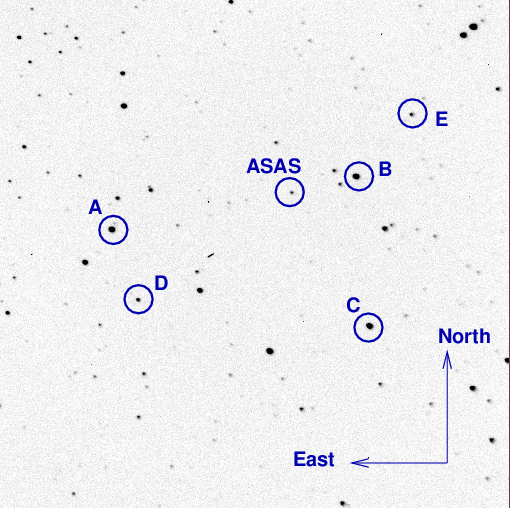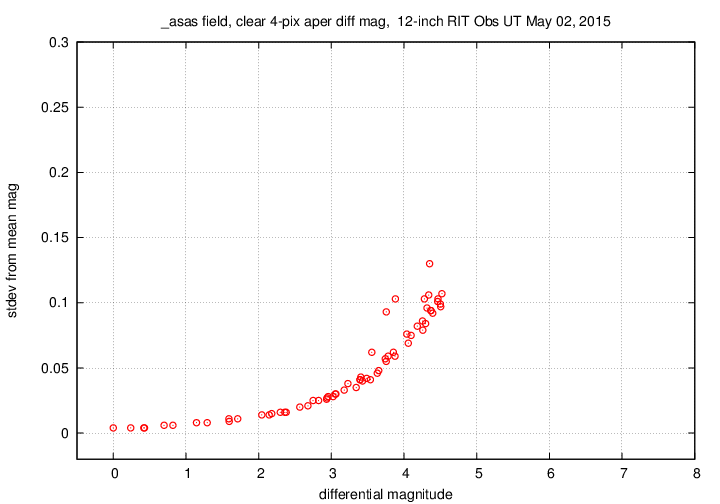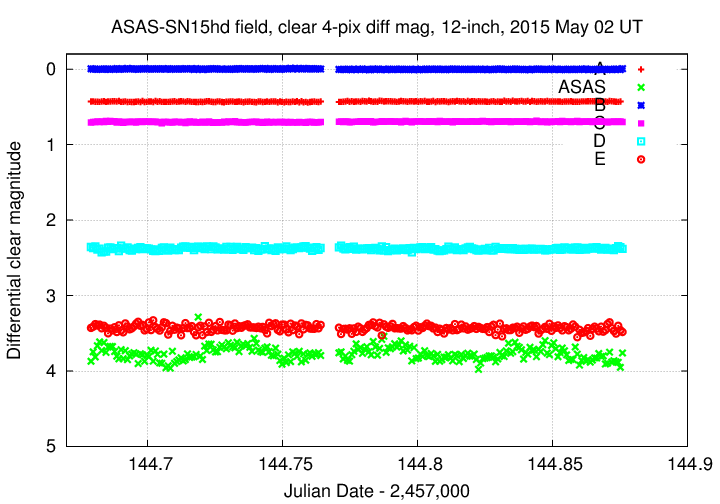
On the night of May 01/02, 2015, I observed the cataclysmic variable star ASAS-SN15hd
It showed regular variation during my run, though the signal-to-noise ratio was low.
The main setup was:
Notes from the night
Here's a chart of the field of ASAS-SN15hd, which is at
RA = 17:31:25.39 Dec = +27:54:29.3 (J2000)
The chart is about 12x12 arcminutes.

Several of the reference stars marked above have photometry measured by the AAVSO. I used star "B" to convert the instrumental magnitudes to the V-band scale (though of course, they are unfiltered measurements)
B = UCAC4 590-060017 = 000-BLQ-179 V = 13.184
Below is a graph showing the sky brightness as a function of time during the observing run. No clouds!

Below is a graph showing the FWHM as a function of time during the observing run. I refocused once, at 2:21 AM.

I used 60-second exposures during this observing run. The target had only about 250 peak counts/2 with this exposure time, and the bright stars A and B about 4000-6000.
Using aperture photometry with a radius of 4 pixels (radius of 5.7 arcsec), I measured the instrumental magnitudes of a number of reference stars and the target. Following the procedures outlined by Kent Honeycutt's article on inhomogeneous ensemble photometry, I used all stars available in each image to define a reference frame, and measured each star against this frame. I used the UCAC4 V-band magnitude of star "B" to convert the ensemble instrumental magnitudes to a reported "V"-band magnitude (but remember, it's a clear filter).
Sigma-vs-mag plot: The target is one of the two outliers at differential mag 3.8.

The target, shown in green, shows smooth variations with an amplitude of about 0.10 mag, somewhat smaller than it was a few nights ago. The variable is also fainter, with an average magnitude around 16.4.

# Measurements of ASAS_SN15hd made at RIT Obs, May 2, 2015 UT, # in good (though bright) conditions, # by Michael Richmond, using 12-inch Meade and SBIG ST-9E CCD. # Exposures 60 seconds long, no filter. # Tabulated times are midexposure (FITS header time - half exposure length) # and accurate only to +/- 1 second (??). # 'mag' is a differential magnitude based on ensemble photometry # using a circular aperture of radius 5.7 arcseconds. # which has been shifted so UCAC4 590-060017 has mag=13.184 # which is its V-band mag according to AAVSO chart 14809BTP. # # UT_day JD HJD mag uncert May02.17902 2457144.67902 2457144.68187 16.625 0.070 May02.17981 2457144.67981 2457144.68266 16.503 0.057 May02.18063 2457144.68063 2457144.68348 16.570 0.064
Last modified 5/03/2015 by MWR.